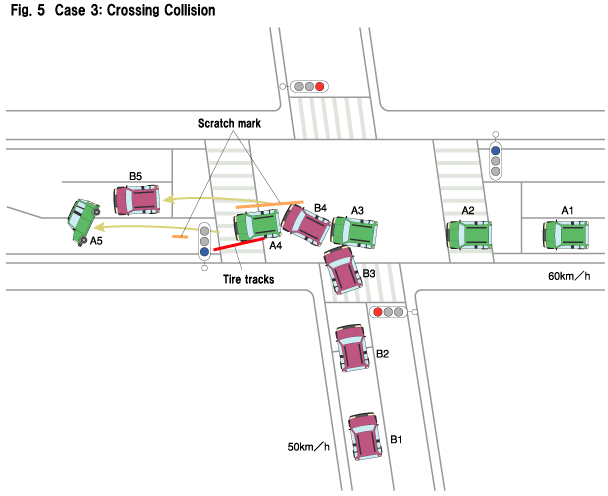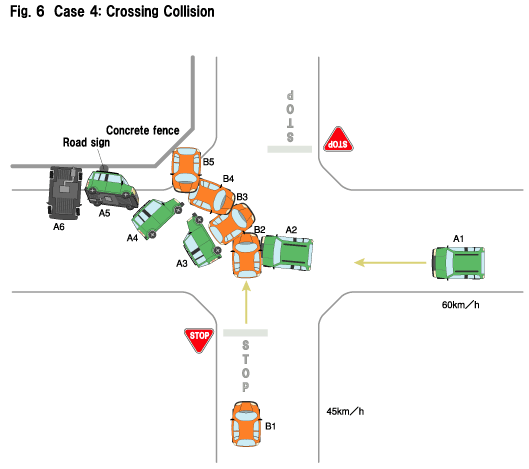
|
Before analyzing the situations in which vehicles are likely to overturn, let's look at four specific examples of accident cases.
[Case 1 (Fig. 3)]
Vehicle A (ordinary passenger car, driven by a female in her 30s) was running in the outside lane of a six-lane expressway (three in each direction) at a speed of 90 km/h. There were five occupants: the driver, one person in the passenger seat, one adult and one child in the second-row seat, and one child in the third-row seat. When a sudden crosswind pushed Vehicle A to the left (A1), the driver made a sharp turn to the right (A2). The car lost its balance, meandering for a short while, skidded sideways (A3), and finally rolled and overturned (A4). While both the driver and the person in the passenger seat had their seat belts fastened and suffered only minor injuries, the two children in the second- and third-row seats had failed to fasten their seat belts and were thrown from the car. The child sitting in the third-row seat died
|
|

|
|
[Case 2 (Fig. 4)]
Vehicle A (light passenger car, driven by a male in his 60s) was running on a straight section of a two-lane road (one in each direction) at a steady speed of 60 km/h. When the driver tried to light a cigarette, he dropped the lighter under his foot. During the time that he took his eyes off the road to pick up the lighter, the car gradually moved to the left. The driver then turned the car sharply to the right (A1) but lost control of his car. The car passed over the center line of the road (A2), ran onto the curb on the right (A3) and thereby turned over. The driver was thrown from the car during the rollover and sustained a serious chest injury.
|
|

|
|
[Case 3 (Fig. 5)]
Vehicle A (ordinary passenger car, driven by a male in his 30s) was running on a two-lane road (one in each direction) at a speed of 60 km/h. Apart from the driver, there was one person in the passenger seat and two children and one adult in the back seat. As soon as the car entered an intersection on a green light, it collided with Vehicle B (ordinary passenger car, driven by a female aged 18) driving into the intersection at a speed of 50 km/h through a red light. The impact forced Vehicle A to skid sideways after which it rolled over and stopped. The driver and the person in the passenger seat both having fastened their seat belts and the two children in their child seats suffered only slight injuries, but the woman sitting in the middle of the back seat had not fastened her seat belt and was badly injured.
|
|

|
|
[Case 4 (Fig. 6)]
Vehicle A (ordinary passenger car, driven by a male in his 40s) approached an intersection with no traffic lights at a speed of 60 km/h. The driver saw Vehicle B (light passenger car, driven by a male in his 60s) coming to the intersection, but he did not stop, thinking that Vehicle B would stop at the stop sign ahead. Despite the stop sign, however, Vehicle B continued to proceed without confirming safety. Vehicle A crashed into the side of Vehicle B, resulting in a lateral skid and rollover. Fortunately, the driver of Vehicle A was only slightly injured thanks to his seat belt.
|
|

|
|
|
UP
Back Next
|
